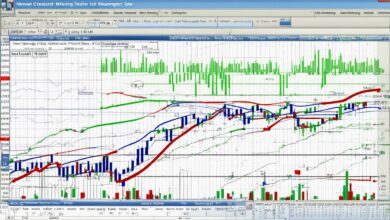Mastering the Basics: How to Read an Option Chain Explained


When it comes to trading options, understanding how to read an option chain is crucial. An option chain is a chart that provides valuable information about available options contracts for a specific security. It consists of two sections: calls and puts. Calls give the right to buy a stock, while puts give the right to sell a stock. The option chain also includes the strike price, which is the price at which the stock is bought or sold if the option is exercised. Additionally, options list various expiry dates, which impact the option’s premium. Real-time option chains can be found on financial websites like Yahoo Finance and trading sites such as Charles Schwab and TD Ameritrade.
Key Takeaways:
- Understanding how to read an option chain is crucial for trading options.
- An option chain provides valuable information about available options contracts.
- It consists of two sections: calls and puts.
- The option chain includes the strike price and expiry dates.
- Real-time option chains can be found on financial websites and trading sites.
Understanding the Components of an Option Chain
When it comes to trading options, understanding the components of an option chain is essential. An option chain provides valuable information about available options contracts for a specific security. Let’s take a closer look at the key components that make up an option chain:
Open Interest (OI)
Open interest refers to the number of options contracts that are traded but not yet exercised or squared off. It can provide insights into the level of interest among traders for a specific strike price. Higher open interest suggests greater liquidity and indicates that there is significant market interest in that particular option.
Volume
Volume in an option chain is the total number of contracts of an option for a specific strike price that have been traded in the market. It is an important indicator of the level of activity and can help traders assess the popularity and liquidity of an option. Higher volume generally indicates greater market interest and liquidity.
Implied Volatility (IV)
Implied volatility represents the market’s expectation for price movement in the underlying stock. It is a measure of the perceived risk and uncertainty associated with the option. Higher implied volatility suggests greater potential price fluctuations, which can impact the option’s premium.
Bid and Ask Prices
The bid price is the price at which buyers are willing to purchase an option, while the ask price is the price at which sellers are willing to sell the option. The difference between the bid and ask prices is known as the bid-ask spread. Traders should pay close attention to this spread as it can impact the overall cost of trading an option.
Strike Price and Premium
The strike price is the price at which the option can be exercised. It determines the price at which the underlying stock is bought or sold if the option is exercised. The premium, on the other hand, is the price an investor pays for purchasing the option. It represents the cost of the option and is influenced by factors such as volatility, time to expiration, and the difference between the strike price and current market price.
Understanding these components of an option chain is crucial for traders looking to make informed trading decisions. By analyzing open interest, volume, implied volatility, bid and ask prices, strike price, and premium, traders can gain valuable insights into market dynamics and potentially identify profitable trading opportunities.
Analyzing an Option Chain for Trading Decisions
When it comes to trading options, analyzing an option chain is a critical step in making informed trading decisions. By examining the data provided in the option chain, traders can gain valuable insights into various factors that affect the profitability of options contracts. In this section, we will discuss how to analyze an option chain and use the information to make effective trading decisions.
One important aspect to consider when analyzing an option chain is distinguishing between in-the-money (ITM) and out-of-the-money (OTM) options. ITM options have strike prices that have crossed over the current market price and have intrinsic value. On the other hand, OTM options have strike prices that have not yet reached the market price. Identifying ITM and OTM options can help traders determine the potential profitability of a trade and align it with their trading strategies.
Another factor to take into account is option liquidity. Liquidity refers to the ease of buying or selling an option without causing a significant impact on its price. High open interest, which indicates the number of outstanding contracts for a specific option, suggests greater liquidity. Traders often prefer more liquid options as it allows for smoother entry and exit from a trade. However, it’s important to note that high open interest does not guarantee the direction of the stock’s movement.
| Option Chain Analysis Summary | |
|---|---|
| Factors to Consider | Implications for Trading Decisions |
| In-the-Money (ITM) vs Out-of-the-Money (OTM) Options | Determines the potential profitability and risk associated with a trade. |
| Option Liquidity | High liquidity provides ease of entry and exit from a trade but does not guarantee the stock’s movement. |
| Strike Price and Premium | Understanding the strike price and premium helps assess the cost and potential profitability of an option. |
In addition to ITM/OTM options and liquidity, traders should also focus on the strike price and premium. The strike price is the predetermined price at which an option can be exercised, while the premium is the price paid to acquire the option. Evaluating the strike price and premium in relation to the underlying stock’s current price allows traders to assess the cost of the option and its potential profitability.
By carefully analyzing the option chain, traders can gather valuable information that can guide their trading decisions. Understanding the concept of in-the-money and out-of-the-money options, as well as assessing option liquidity and strike price/premium, can help traders make informed choices that align with their risk tolerance and trading strategies.


The Importance of Mastering Option Chain Reading
Understanding how to read an option chain is essential for making informed trading decisions. By mastering this skill, we can gain valuable insights into market conditions and identify potential opportunities. Option chain reading enables us to assess the liquidity, volatility, and profitability of options contracts, providing us with a comprehensive understanding of the options market.
When we analyze an option chain, we can evaluate the supply and demand for different strike prices and expiry dates. This information allows us to gauge market sentiment and identify trends that may impact the value of options. By understanding the components of an option chain – open interest, implied volatility, bid and ask prices, and volume – we can make informed decisions about buying or selling options.
One important aspect of option chain reading is assessing the overall market conditions. By analyzing the data provided in the option chain, we can better understand the current state of the market and its potential future direction. This allows us to align our trading strategies with the prevailing market trends and increase our chances of making successful trades.
In conclusion, mastering the art of reading an option chain is crucial for any trader who wants to make informed trading decisions. By understanding market conditions and analyzing the components of an option chain, we can navigate the complex world of options trading with confidence. So, let’s dive into option chain reading and unlock the potential it holds for our trading success.




